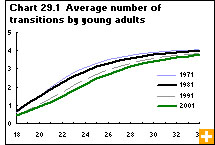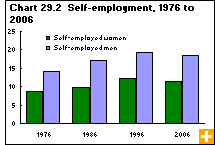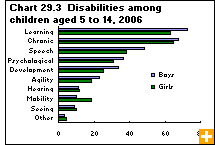Common menu bar links
Society and community
Archived Content
Information identified as archived is provided for reference, research or recordkeeping purposes. It is not subject to the Government of Canada Web Standards and has not been altered or updated since it was archived. Please contact us to request a format other than those available.
Social, economic and demographic changes are constantly reshaping Canadian society. Today, young adults are taking longer to achieve their independence. More women are self-employed and more are bettering their job opportunities with higher levels of education. Seniors are finding the path to retirement is no longer direct or one way.
Baby boomers are becoming a ‘sandwich generation’ as they care for both children and aging parents. Parents of children with disabilities are reporting unmet needs and difficulty accessing special education services. Gays, lesbians and bisexuals are enjoying new legal protections, but are still experiencing discrimination at higher rates than heterosexuals.
Social scientists are calling it ‘delayed transitions.’ Today’s young adults are leaving school later, staying longer in their parents’ home, entering the labour market later, and postponing conjugal unions and childbearing. Along with delaying marriage, some Canadians are staying single.
Delayed transitions, fewer transitions
In 1971, three out of four 22‑year-olds were out of school. Half were married and one in four had children. Thirty years later, just half of the 22‑year-olds in 2001 were out of school. Only one in five was in a conjugal union (usually a common-law relationship) and just one in eleven had a child.
The delays vary for men and women. In 2001, men at age 34 had made fewer transitions than their counterparts had in 1971. For example, they were less likely to have full-year full-time work. Partly, this may stem from economic changes that made the labour market more dynamic but also more unstable. Work today is less likely to be full-time and tends to offer fewer benefits, which has contributed to insecurity, especially among young men. It is also contributing to delays at other stages of life.
As well, both men and women have upgraded their level of education to take advantage of the premium that university graduates enjoy in the labour market. This by itself has delayed other transitions to adulthood.
By contrast, 34‑year-old women in 2001 had made just as many transitions as 34‑year-old women did in 1971. However, those transitions were less likely to include marriage and childbearing and they were more likely to include full-year full-time work.
More women are self-employed
A growing number of women are self-employed. In 2006, close to 900,000 women, or 11% of all those with jobs, were self-employed, up from 9% in 1976. Self-employment has grown about as fast among women as it has among men over the past quarter century, though women are still less likely than men to be self-employed: 11% versus 19% in 2006.
The likelihood of women being employed rises with higher levels of education. In 2006, 75% of women with a university degree and 69% of those with a certificate or diploma from a community college worked for pay or profit, compared with 61% of those with some postsecondary training and 59% of high school graduates. By contrast, 38% of women who had attended but not completed high school had a job, while 15% of women who had not gone beyond Grade 8 had one.
The majority of employed women continue to work in occupations where women have traditionally been concentrated. In 2006, 67% of employed women were working in teaching, nursing or a related health occupation, in a clerical or administrative job, or in a sales or service position. This compared with 30% of employed men.
Path to retirement is not so direct anymore
For many seniors, the straight line of school-work-retirement is less certain these days. Seniors are more likely to move in and out of the workforce than ever before. From 1998 to 2005, leisure time declined and hours in full-time labour increased for Canadians aged 55 to 64. Both men and women were spending roughly an hour a day more in paid work than they were in 1998. Among women, the biggest impact was a decline of more than half an hour a day in the time they devoted to leisure activities.
Studies have found that women are much more likely than men to see retirement as involving more than just getting a pension or stopping paid work. Women tend to include in their concept of work the time they spend doing unpaid work, such as care-giving and volunteering.
Delayed marriage, postponed children and long-lived parents have given rise to a ‘sandwich generation’ among baby boomers. These individuals are caught between the often-conflicting demands of still caring for children while also caring for parents
Disability rising among children
The prevalence of disability among children has increased in Canada. In 2006, 4.6% of children aged 5 to 14 had one or more disabilities, up from 4.0% in 2001. The rate was higher among boys.
In the 2005/2006 school year, 163,730 children with disabilities were attending school, most on a part-time basis. Of this group, 43%, or 70,600 children, were attending special education classes. Almost two out of three attended these classes part-time. Learning disabilities are the most common condition requiring special education. Some children have more than one activity limitation such as speech or language difficulties, developmental disabilities, or emotional, psychological or behavioural conditions.
Unmet needs are an issue. In 2006, not all children aged 5 to 14 with disabilities received special education when they needed it, in the opinion of their parents. Nearly half the children in this group had severe or very severe disabilities.
Two-thirds of parents of children with very severe disabilities reported challenges in obtaining special education.
Discrimination persists
Although Canada has recently protected the legal rights of individuals of all sexual orientations, including recognizing legal marriage for same-sex couples, discrimination is still being experienced by gays, lesbians and bisexuals at higher rates than among heterosexuals.
In a 2004 study, the proportion of gays, lesbians and bisexuals who felt they had experienced discrimination was about three times higher than that of heterosexuals. Moreover, 78% of gays and lesbians who experienced discrimination believed it was because of their sexual orientation, compared with 29% of bisexuals and 2% of heterosexuals. Gays, lesbians and bisexuals were most likely to report its occurrence at work or when applying for a job or a promotion, though discrimination was more common for them in all locations than it was for heterosexuals.





